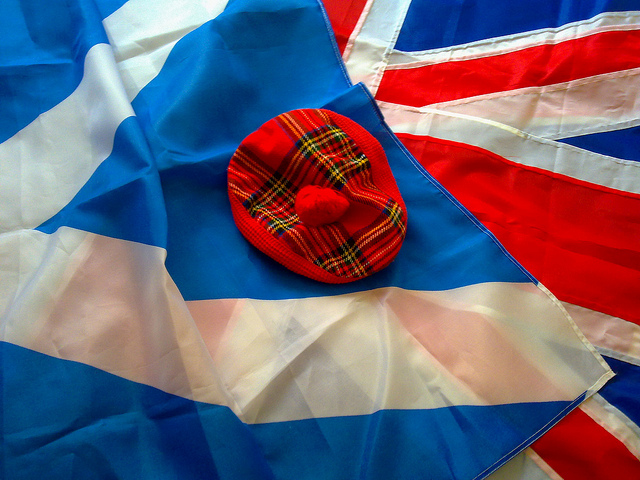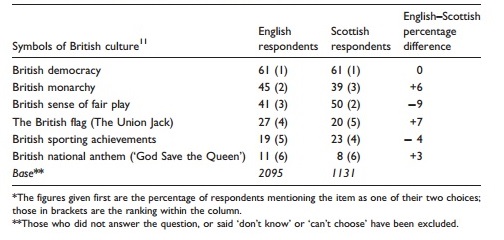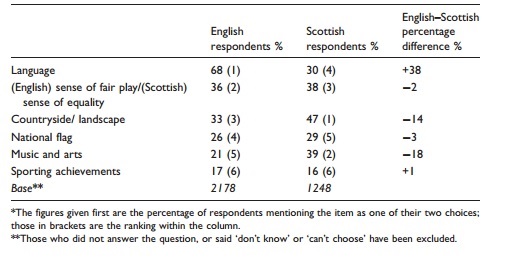Symbols of shared Britishness are less important in sustaining the union than economic and political factors
The Referendum on Scottish Independence in September 2014 provides a valuable context for studying territorial identities in the UK. In the United Kingdom, comparing the diversity of ‘national’ experiences helps us to understand the salience of national symbols. David McCrone and Frank Bechhofer show that although these symbols are important, they will bear less on the outcome of the forthcoming vote than will economic and political factors.
Symbols such as flags help to ‘personalise’ the nation, to connect the institutional to the everyday. Objects serving as symbols acquire a unique prestige. As Emile Durkheim observed: ‘a rag of cloth becomes invested with sanctity and a tiny piece of paper can become a very precious thing’. Symbols like flags and anthems were deliberately created to evoke national identification in the 19th century, but there are other important cultural symbols: music and the arts, sport, landscape or countryside, language, as well as what are deemed ‘national’ values.
Because there are considerable differences between English and Scottish cultures resulting from their histories and the differing legal, educational, political and religious systems and institutions, one would expect differences in the importance attributed to various symbols of English and Scottish culture.
We might also expect that an individual’s sense of their own national identity will affect this process of identifying particular symbols of the nation and state, and that Scots take a more ‘political’ and a less ‘cultural’ view of such cultural symbols than the English do of theirs.
Respondents to the 2006 British and Scottish Social Attitudes surveys were asked to select from a list of symbols which ones they thought most important to British culture on the one hand, and English/Scottish culture on the other. We were asking respondents what they saw as being the important symbols of these cultures, and not whether they identified with or approved of them. The tables give the percentage of respondents mentioning the item as first or second choices; those in brackets are the ranking within the column.
Table 1: Symbols of British Culture among English and Scots
We find that the English and the Scots agree broadly on the ranking of the symbols of British culture. A constitutional symbol, democracy, is the most popular symbol in both countries and the other, the monarchy, ranks second in England and third in Scotland. The least chosen symbols are those of conventional cultural iconography (the anthem, sport and the flag).
A similar table for national symbols shows:
Table 2: National Symbols in England and Scotland
What is striking is that language as the dominant symbol is mentioned by two-thirds of English respondents. The Scots place ‘landscape’ at the top of their choices, followed on an equal par by ‘music and the arts’ and ‘sense of equality’. The national flag (the Saltire), and Scots or Gaelic language are broadly equal, and sporting achievements are, as in England, the least important. Language, in this case, Gaelic or Scots, is mentioned by three in every ten Scottish respondents. Even when we exclude ‘language’ from the English and Scottish lists, we find the Scots placing greater emphasis than the English on ‘cultural’ features such as countryside/landscape, music and the arts.
Perhaps surprisingly, people’s own sense of identity, British, English or Scottish, has little effect on the rankings of either British or national symbols. In both countries state identity –being British – has very little systematic effect on how respondents rate ‘British’ symbols. People do not have to think of themselves as ‘British’ to rate ‘British’ symbols in a broadly similar way. Although those who are ‘only or mainly English’ tend to choose the (English) flag and people who say they are only or mainly British are more likely to choose English music and arts, there is considerable consensus among the English about the importance to English culture of the various symbols regardless of national identity.
It might seem ‘obvious’ to think that English and Scottish people would differ in the way they rank state and national symbols, and especially that national identity would be an important discriminator. Some politicians, for example, believe that emphasising British symbols will halt or reverse what they see as the decline in ‘Britishness’ and in turn strengthen the British state. This seems misguided given that the importance both the English and the Scots attach to symbols of British culture is not associated with their own self-identification. Even more striking is that our data show that both national and state symbols are mainly judged independently of respondents’ own national identity.
We might expect the English to take a ‘cultural’ view of being English, whereas the Scots are more ‘political’, given constitutional developments. We devised a 7-point scale running between 1 – ‘cultural’ and 7 – ‘political’. While the mean scores for both the English and the Scots are on the cultural side of the mid-point (4.0), the English distribution is skewed towards the political end with a mean of 3.54 compared with 3.17 in Scotland. In other words, the Scots are less ‘political’ than the English, although the similarities far outweigh the differences between them.
Both the Scots and the English have no difficulty assessing British symbolism and they do it in similar ways. ‘Britain’ remains an important and meaningful frame of reference. Although more and more people in England and Scotland do not define their national identity primarily as British, being British does have content and meaning in terms of important symbols of British culture which are widely and normatively held. Furthermore, in both countries it takes an institutional and constitutional form: the institutions of democracy and a (constitutional) monarchy together with a sense of fair play, rather than a narrowly ‘cultural’ form, associated with orthodox icons of flag and anthem.
What are the implications of our findings for the constitutional future of the British state? On the one hand, even if people do not think of themselves as ‘British’ in any strong sense, they are still able to identify shared and important symbols of British culture. Agreement on the symbolic meaning of Britishness, however, far from indicating that the idea of being British is fairly secure, only points to the strength of the concept rather than an attachment to the reality of the British state. Such symbols are almost certainly less important in sustaining the British state than broader economic and political factors. This view is strengthened both because there is dissociation between people’s own sense of national identity and what they see as the important British symbols, and because they are seen rather more in cultural rather than political terms.
—
Note: this post represents the views of the author and not those of Democratic Audit or the LSE. Please read our comments policy before posting. For a full account of the research findings, see ‘Imagining the nation: Symbols of national culture in England and Scotland’, in Ethnicities, vol.13(5), 2012. The shortened URL for this post is: https://buff.ly/1iVXenb
—
 David McCrone is Emeritus Professor of Sociology, and co-founder of the University of Edinburgh’s Institute of Governance in 1999. He is a Fellow of the Royal Society of Edinburgh, and a Fellow of the British Academy
David McCrone is Emeritus Professor of Sociology, and co-founder of the University of Edinburgh’s Institute of Governance in 1999. He is a Fellow of the Royal Society of Edinburgh, and a Fellow of the British Academy
 Frank Bechhofer is a Research Fellow in the Institute of Governance and Professor Emeritus of Social Research. He started his career as a Research Officer in the Department of Applied Economics at Cambridge University and in 1965 came to Edinburgh as a lecturer in the Department of Sociology. He founded the Research Centre for Social Sciences in 1984 and was its Director until he took early retirement in 1997, in order to concentrate on his research.
Frank Bechhofer is a Research Fellow in the Institute of Governance and Professor Emeritus of Social Research. He started his career as a Research Officer in the Department of Applied Economics at Cambridge University and in 1965 came to Edinburgh as a lecturer in the Department of Sociology. He founded the Research Centre for Social Sciences in 1984 and was its Director until he took early retirement in 1997, in order to concentrate on his research.
The article is the product of a collegiate form of working in which the data, the analysis and the drafts have been discussed by both authors throughout, and they are equally responsible for it. The authors are grateful to The Leverhulme Trust for supporting their research since 1999, and to the publisher of Ethnicities, Sage Publications, for permission to reproduce part of the article.








 Democratic Audit's core funding is provided by the Joseph Rowntree Charitable Trust. Additional funding is provided by the London School of Economics.
Democratic Audit's core funding is provided by the Joseph Rowntree Charitable Trust. Additional funding is provided by the London School of Economics.
sac hermes kelly prix
Does your blog have a contact page? I’m having problems locating it but, I’d like to send you an e-mail. I’ve got some suggestions for your blog you might be interested in hearing. Either way, great blog and I look forward to seeing it develop over…
louis vuitton sac
Hey there would you mind sharing which blog platform you’re working with? I’m going to start my own blog in the near future but I’m having a difficult time selecting between BlogEngine/Wordpress/B2evolution and Drupal. The reason I ask is because yo…
锘縮acs chanel d occasion
Its such as you read my mind! You appear to know a lot approximately this, like you wrote the book in it or something. I feel that you simply could do with a few p.c. to drive the message home a little bit, however other than that, that is great blog.…
maillot om 2013
I love reading through your publish. It is the two beneficial and exciting to me. I will come again once more to see your new posts.
Brilliant article for nationality & identity #SCLY1 Symbols of shared Britishness… https://t.co/ZCKP1WWc9e
Symbols of shared Britishness are less important in sustaining the union than economic and political factors https://t.co/g0RWWrAkvV
Symbols of shared Britishness are less important in sustaining the union than economic and political factors https://t.co/3928lHfOu7
@democraticaudit The image for Table 1 is repeated twice. I’d like to see the stats in Table 2! 🙂